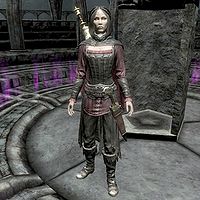| Lady Serana | |||
|---|---|---|---|
 Lady Serana
Lady Serana |
|||
| Race | Nord | Gender | Female |
| Resided in | Castle Volkihar Dimhollow Crypt |
||
| Appears in | Dawnguard | ||
Serana is the estranged daughter of Lord Harkon and Valerica. She and her family became Vampire Lords after her father made a deal with Molag Bal and founded the Volkihar clan at an early point in history. Her mother hid her within Dimhollow Crypt to keep her out of the reach of her father and his goals to complete the Tyranny of the Sun prophecy.[1] As of 4E 201, Serana is thousands of years old.
BiographyEdit
Serana was born to Valerica and Harkon, who was initially a cruel tyrant that ruled over an unknown portion of Skyrim. As a Daughter of Coldharbour, Serana's transformation was unpleasant and emotionally scarring due to Molag Bal's cruel nature.[2] Serana grew up very close to her mother and distant from (but not opposed to) her father. Her relationship with her mother was as loving and nurturing as it could be, considering that they were both creatures of the dark. She learned necromancy and other sorts of magic at her mother's side, and she was a powerful mage in her own right.[3]
Even as a child, hers was a fairly lonely life. She's naturally somewhat defensive, though not cold. She can deftly avoid difficult topics and turn the conversation back around into something you thought you wanted to talk about. She's built up these defenses because she has a quick temper and strong passion, so she doesn't let people get too close lest they fall victim to them. She's been taught to genuinely care about those who befriend her, but only so much as they prove worthwhile. She also has a touch of self-deprecating humor and awareness. She's smart, but a bit naive. She remembers snow elves and dwarves and was somewhat sad to hear about their passing.[3]
Eventually, Harkon became obsessed by the Tyranny of the Sun prophecy which required the blood of Serana or her mother to power Auriel's Bow to blot out the sun. In defiance of Harkon, Valerica fled with Serana and took two of the Elder Scrolls that were needed to fully understand the prophecy. While Valerica hid in the Soul Cairn with hers, Serana was sealed inside Dimhollow Crypt with the other scroll on 4th Hearthfire,[4] some point during the Interregnum, prior to the rise of the Septim Empire at the end of the Second Era.[nb 1] Valerica constructed a complicated suspended animation tube to store her in, and placed gargoyle statues to frighten away the curious.[5]
Many years later, Serana was awakened by the Last Dragonborn, who had been sent to investigate Dimhollow Crypt by the Dawnguard, and returned to Castle Volkihar. After being sealed in Dimhollow Crypt, she was curious about what the world has become.[3] She questioned her father's lust for power and found an ally in the Dovahkiin. The pair ventured into the Soul Cairn to find Valerica and her Elder Scroll.[1] Valerica cared for Serana, but not in an especially motherly way. This came to the forefront when Serana confronted Valerica in the Soul Cairn and makes her mother realize that she's been used as a pawn in her parents' game.[3] They then searched the Forgotten Vale and retrieved Auriel's Bow from two of the last known Snow Elves. Together, Serana and the Last Dragonborn confronted and slew Lord Harkon. Serana was then free to live out her immortal life however she saw fit. It is unknown if she eventually sought out a cure for her vampirism or if she chose to remain a vampire.[1]
GalleryEdit
NotesEdit
See AlsoEdit
- For game-specific information, see the Skyrim article.
ReferencesEdit
Note: The following references are considered to be unofficial sources. They are included to round off this article and may not be authoritative or conclusive.